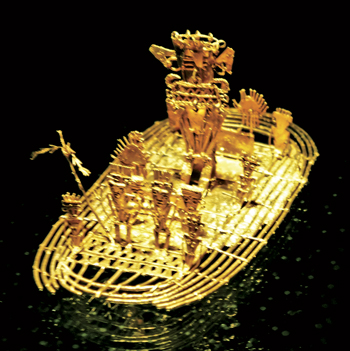Vol. 233 No. 12
Search for El Dorado
|
.jpg)
|
The indigenous populations of Colombia had developed techniques for mining and smelting gold as early as 2,500 B.C. They created exquisite masks, breast plates and rings to be worn by the tribal chiefs and shamans. In the eastern highlands of Colombia, the Muisica people sacrificed their gold ornaments on auspicious occasions to appease the Gods. On such occasions, the tribal chief was adorned with gold ornaments and sprinkled with gold dust. The chief was then placed aboard a ceremonial raft and paddled to the center of Lake Guatavita. When the Sun’s rays reflected off the chief’s headdress at noon, the commoners, gathered around the rim of the lake, were also instructed to cast off some of their gold ornaments.
After the Spaniards conquered Colombia in the 16th century, they heard about El Dorado (The Guilded One) tribal chief. The Spaniards wanted all the gold and emeralds they could confiscate from Colombia, and silver from mines in Mexico, to enrich their palaces in Lisbon and to trade for Chinese silks and porcelain.
These days, Colombia is seeking black gold to fuel its economic success story. According to Proexport Colombia, the country is experiencing extraordinary growth. The world’s second largest Spanish-speaking country after Mexico, Colombia has a population of 47 million, with 55% of the population less than 30 years of age. The country has seven metropolitan areas, each with a population in excess of 1 million people. To support this urbanization, and the consequent need for energy, Colombia’s oil and gas industry has grown 84% since 2004, to produce 985,000 bopd in 2011.
 |
| A representation in gold of the ceremonial barge used by the tribal chief and shamans during the sacrifice of their gold objects to appease the Gods. Source: Museo Del Oro in Bogota, Colombia. |
|
Future growth in oil and gas production depends upon applying enhanced recovery techniques to existing fields. During the recent 2012 Colombia Oil & Gas Expo, the state-run oil company, Ecopetrol, presented plans to improve the oil recovery ratio from existing fields to increase the production rate to 1.15 million bopd by mid-2014.
The second strategy for Colombia is to open up more of the country for exploration as 80% of the country is yet to be explored. In the recent Ronda Colombia 2012, 49 blocks were offered. While the largest number of blocks was awarded to Ecopetrol, winners included Anadarko, ExxonMobil, CNPC and ONGC. Presidente Orlando Cabrales Segovia of ANH, which coordinates the licensing rounds, told World Oil that his agency has accomplished 50% of the work by creating the right business conditions for E&P operators. The other 50% of the effort, Segovia said, is for the geologists to do their work and deliver major discoveries!
Perhaps it is time for Colombians to pay homage at Lake Guatavita, so that the Gods are as kind to their country as they were to Brazil. The indigenous people knew that they were helpless against the might of nature and the Gods. It is a lesson that even the residents of the U.S. East Coast have learned with the death and destruction caused by Hurricane Sandy. Pray tell, why couldn’t the chief of our tribe, Barack Obama, and Chris Christie, the shaman from New Jersey, have adorned gold ornaments, and sprinkled themselves with gold dust, before going out in a barge on the Hudson River and sacrificing gold ingots from Fort Knox? 
|

.jpg)


